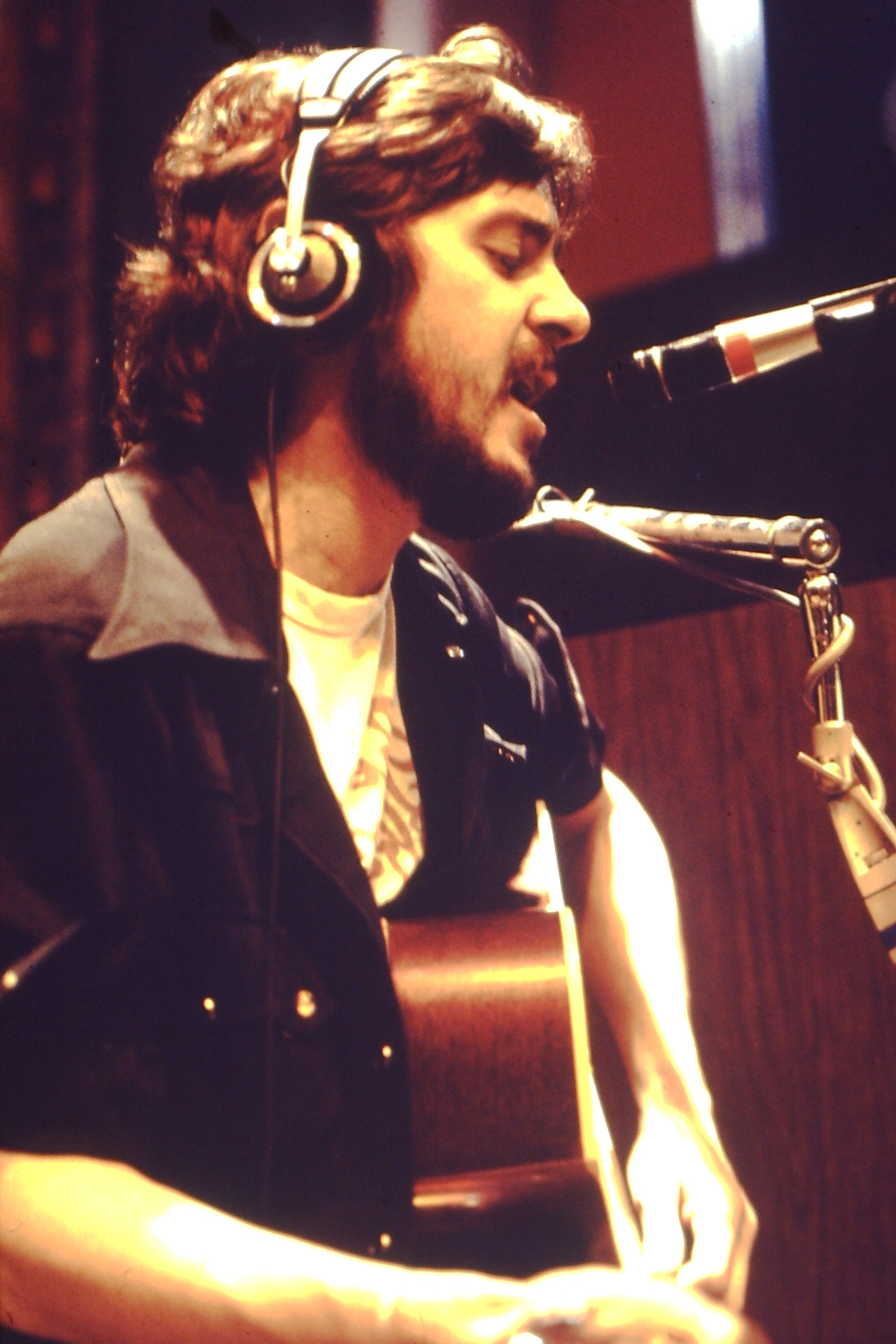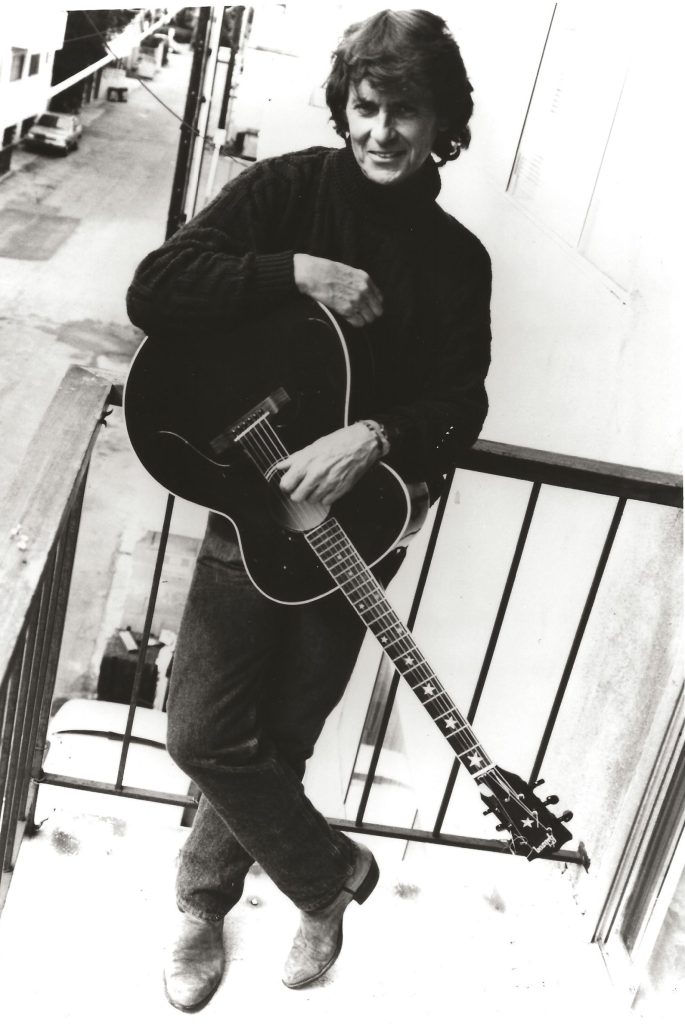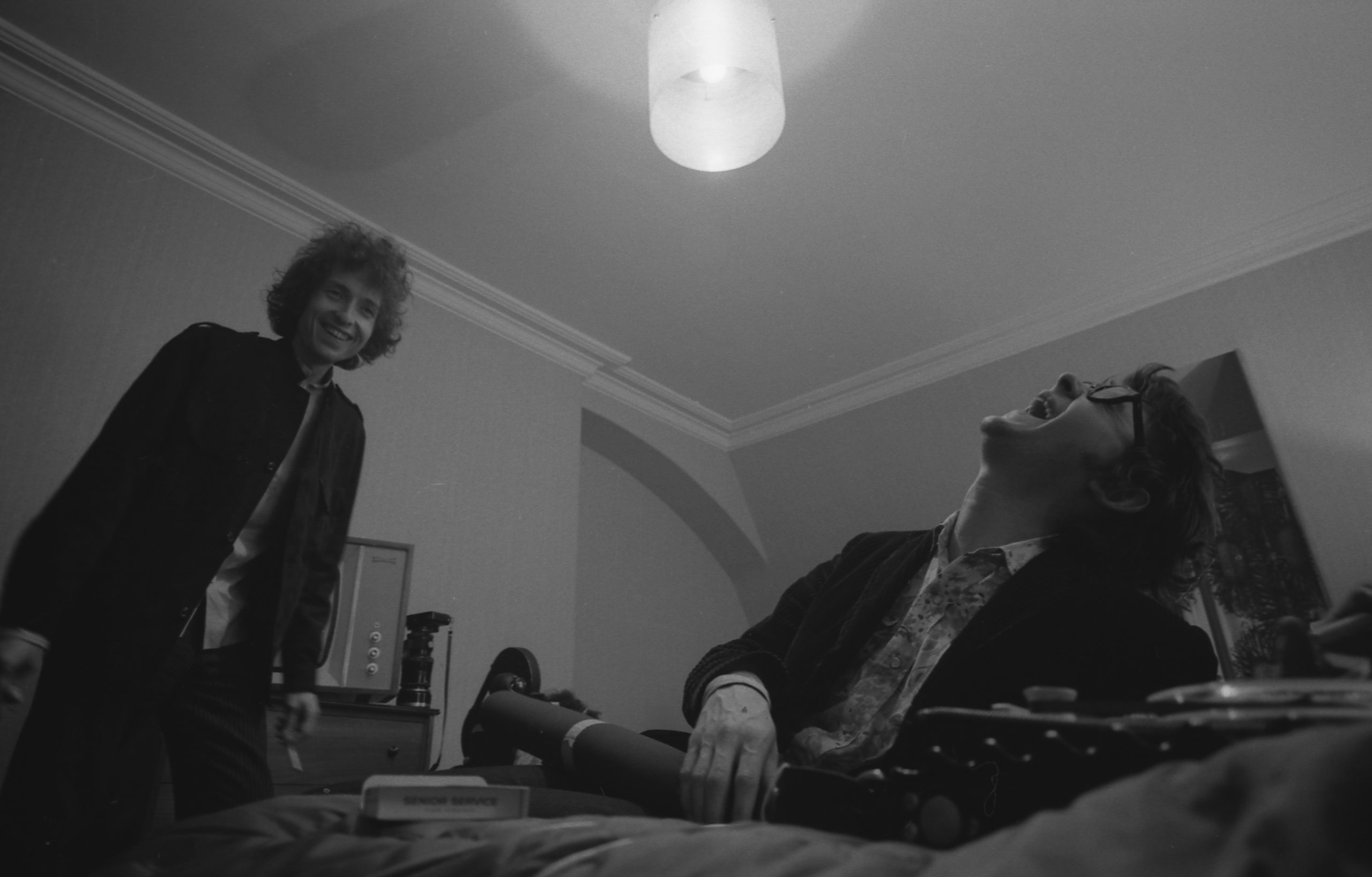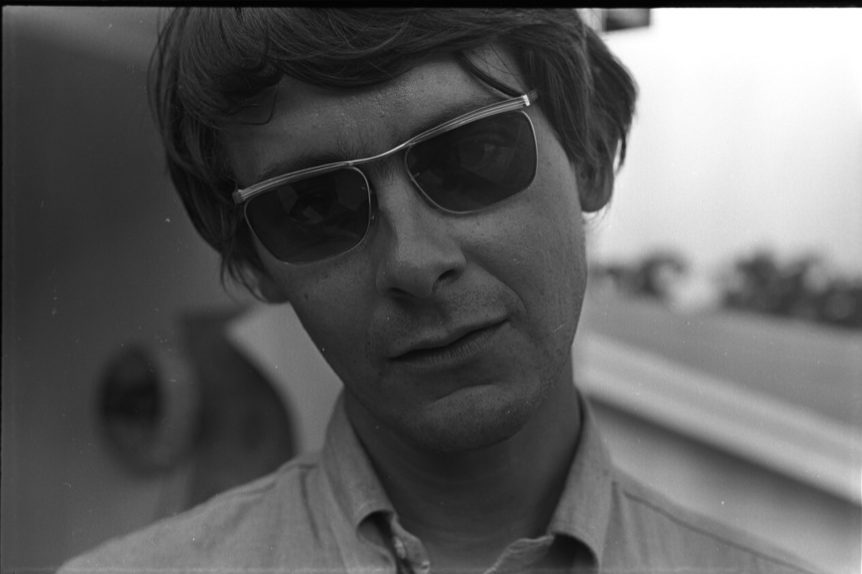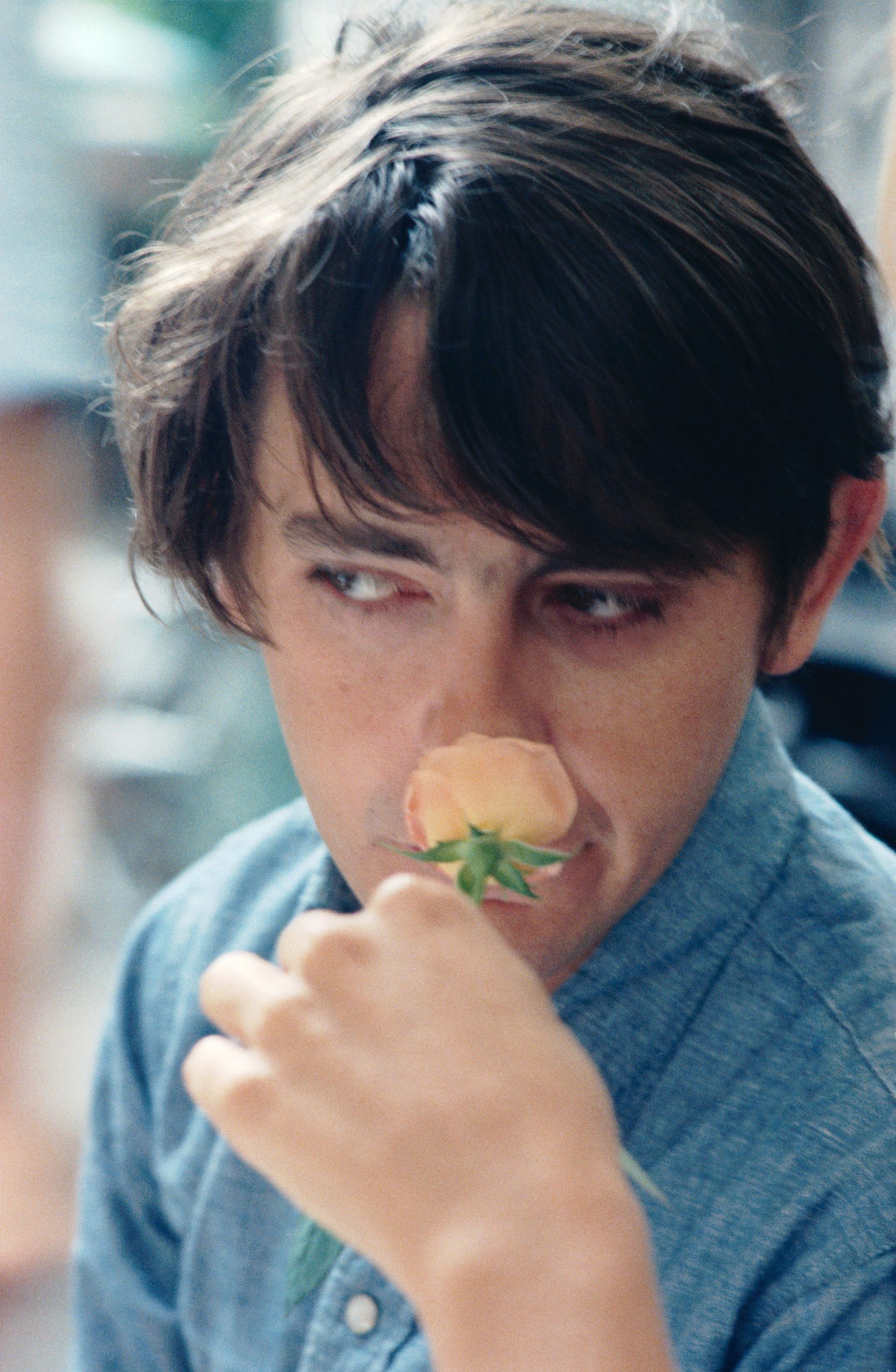Oh, there were the fortunate few who got hip to his musical conjuring act over a career that spanned six decades. Some were lucky enough to have stumbled on him when this Akron, Ohio native turned up on the New York folk music scene of the late-‘50s and early-‘60s.
Others found him after he started making records in 1974 with his knockout debut solo album for which music mogul David Geffen signed him to his rapidly blossoming Asylum Records label, at that time the home for arguably the most imposing class of singer-songwriters of that era of pop music.
Neuwirth took his well-deserved place alongside the likes of Joni Mitchell, Jackson Browne, Laura Nyro, Tom Waits, the Eagles’ Glenn Frey and Don Henley, J.D. Souther and his big coup of that period, Bob Dylan.
Of course, Bob Dylan and Bobby Neuwirth had been pals since they’d started hanging out together in the Greenwich Village folk clubs.
That’s Bobby you see alongside Dylan and Allen Ginsberg in the fabled “Don’t Look Back” documentary. And it was Neuwirth again at Dylan’s side in 1975 and ’76 as one of the chief instigators and featured performers on the Rolling Thunder Revue rock ‘n’ roll circus.
That Neuwirth’s own music never became as widely known as many of his peers is little short of tragedy, but not entirely a mystery. He simply never developed a craving for fame and fortune as a rock ‘n’ roll star.
“I just never felt led in that direction,” Neuwirth told the Los Angeles Times in 1989. “I had other outlets. I was a painter, so it never occurred to me to do any of those things” that might promote his music. His commitment to his visual art endeavors also affected the quantity of time and energy he could devote to music.
“I was painting. I didn’t get to sit around and write songs,” he told music journalist Mike Boehm. “So when I went on stage, I just made songs up. … That’s what kept me being invited back. Rather than the quality of the [songs], it was the sheer recklessness of it. I got the reputation for [being] this guy who would take a kamikaze approach by going on stage with almost no material,” he said. “I would get lucky a lot of the times–it would just fall into place.”
It’s a characteristically self-effacing assessment of his own talent.
In the liner notes for Neuwirth’s 1988 album “Back to the Front,” his longtime friend and musical cohort T Bone Burnett wrote, “I’ve sat around the table many a late night, passing guitars around, and when a guitar got to Neuwirth, he would start playing the best song any of us had ever heard.
“Someone would ask who wrote that one, and after a while, it would become clear that he had been making it up as he went along, and that he couldn’t remember a note he had sung, not that he had really sung any notes. I just wanted to say that I think in many ways, he’s the best pure songwriter of any of us.”
Kris Kristofferson once called Neuwirth “a guardian angel of sorts during a magical time of my life…. A Shakespearean jester who’s wiser than all the rest.”
At the same time, Neuwirth always said he liked doing things for fun and for free. And he believed he could get a lot more done being anonymous.
Guitarist, songwriter and producer Steven Soles has referred to his longtime friend as “this unsung American master of the postwar era. After you spent time with Neuwirth, you felt smarter and inspired. He always challenged you.”
Those who knew him best, to a person, frequently cite his passion about art for art’s sake, music for music’s sake.
As one of his many musical disciples, singer-songwriter Peter Case, put it at a 2022 memorial concert in Los Angeles after his death at age 82, “These songs weren’t written for money. These songs were written to sing one-on-one to people in the middle of the night, if you know what I mean.”
Among others singing both Neuwirth’s songs and his praises at that event: Burnett and Soles, Maria Muldaur and her daughter Jenni, Happy Traum, Victoria Williams, Laura Cantrell, Sam Phillips and her daughter Simone, Vince Bell, Phranc, Bob Thiele and Eric Clapton.
Neuwirth has long been celebrated both for his longstanding compassion for others’ suffering, as well as his rapier wit.
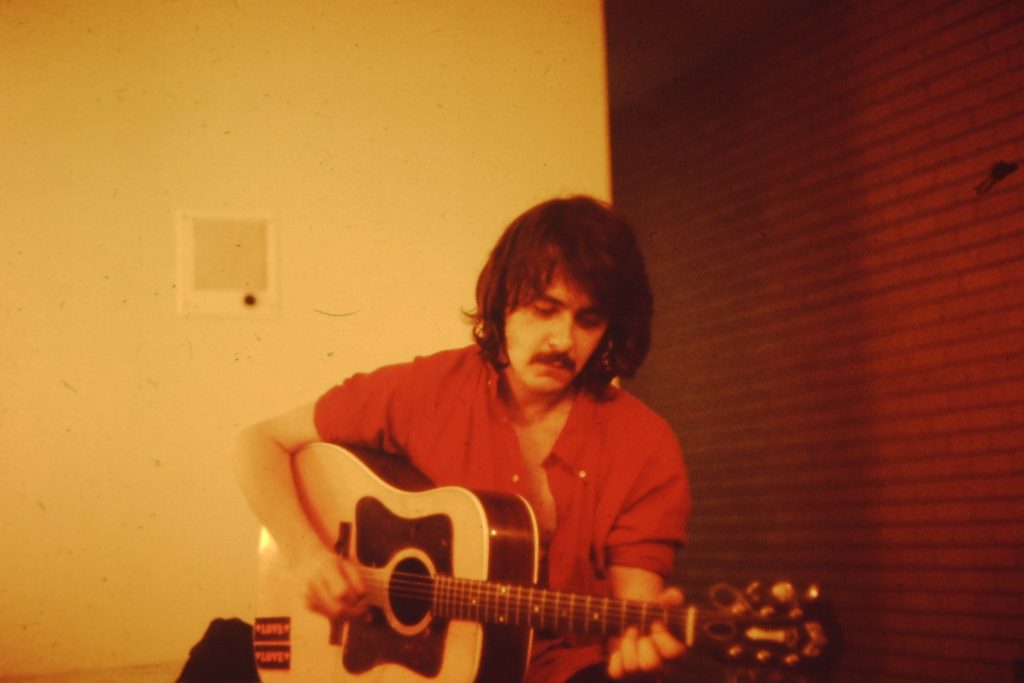
In a recent New Yorker interview, Joan Baez paid homage to Neuwirth’s unfailing ability to raise his friends’ spirits when needed. Asked about the dedication in her latest book “Am I Pretty When I Fly?” Baez cited Neuwirth as the first example of those to whom she dedicated it “To everyone who has ever made me laugh.”
“When my sister Mimi and I lived in Belmont, outside of Boston, she was struggling through school,” Baez said. “I was pretending I was going to college, which was just awful. We were unhappy all the time. We would call Bobby Neuwirth, and he would come up there and make us laugh. He was just totally reliable. It was refreshing and renewed our lives.
Even among celebrated musicians, Neuwirth stood out.
“He was a wonderful friend,” said Maria Muldaur, who remembered meeting him in 1962, “and just the coolest, hippest, funniest guy I ever met in my whole 80 years of life.”
In many ways Neuwirth approached making music the same way he approached the artwork that was at least as important a part of his life and legacy has the songs he wrote, sang and fed to other musicians.
Kris Kristofferson remembers meeting Neuwirth in New York in the late-‘60s, when Kris had visited with fellow Texan Mickey Newbury, who was playing at the Bitter End at the time. All were part of a community of musicians and visual artists that also included Patti Smith, Andy Warhol, Ramblin’ Jack Elliot, actor Michael J. Pollard, folk singer Odetta and artist Larry Poons, among others.
As he often did throughout his life, Neuwirth was singing the praises of one of his artist friends to the others. “When l came back from Peru,” Kristofferson once wrote about his trip to the Andes in 1970 to compose the score for Dennis Hopper’s film “The Last Movie,” “one of the first things I heard from a photographer friend was that Janis Joplin had sung ‘Me and Bobby McGee’ at a concert. Bobby taught her that song before I ever met him. So l was indebted.”
“We ran together for a while in a time of guts and glory and dreams coming true or not,” Kristofferson recalled. “I guess he told me more surprising things that turned out to be true than anyone else I’ve run into, personally, on the planet.”
Kristofferson brought Coolidge out on the road with him and his band, which included guitarist Stephen Bruton, keyboardist Donnie Fritts and bassist Terry Paul. Coolidge invited keyboardist Mike Utley to come play on her portions of their shows, and soon the community spirit found members of each entourage backing the others.
Utley, the longtime musical director for Jimmy Buffett’s band, already had been playing for Coolidge as part of the Dixie Flyers when she and Kristofferson teamed. At the time, Kristofferson had been bringing Neuwirth onstage during his shows, which is how Neuwirth and Utley met.
Between his commitment to his visual art activities and a wish to maintain some degree of anonymity after he became sober and committed himself to helping others wanting to do the same, he had time for making albums of his own only sporadically.
But there was never a shortage of esteemed collaborators ready and willing to work with him, whether on his 1988 album “Back to the Front” (produced by Soles and featuring support from Burnett, Mansfield, Eagles member Bernie Leadon, Willie Nelson’s longtime harmonica player Mickey Raphael, stringed instrument whiz Sandy Bull, and longtime Linda Ronstadt associate Kenny Edwards); his 1994 song cycle collaboration with John Cale, “Last Day on Earth”; or his exquisite deep dive in 2000 into the musical riches of Cuba with arranger, conductor and pianist Jose Maria Vitier, “Havana Midnight.”
“One thing for sure: Bob always had boundless energy and creativity,” David Mansfield said recently. “When he got sober, he channeled both not only into his art, but also into tirelessly serving others. He became a first responder, albeit the hippest one you’d ever seen. Which is, maybe, part of how he literally saved so many lives.”
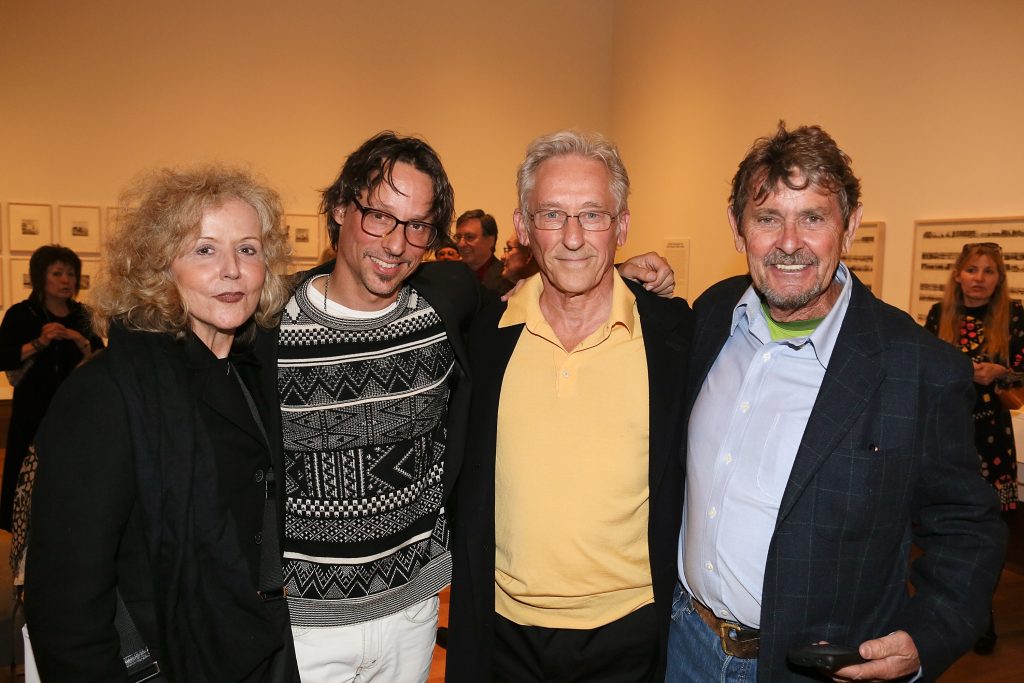
Album Credits
SIDE ONE
- ROCK & ROLL TIME 3:10
B. NEUWIRTH/ K. KRISTOFFERSON/ R. McGUINN RESACA MUSIC CO. BMI - KISS MONEY 3:05
B. NEUWIRTH DRY CLAM MUSIC BMI - JUST BECAUSE I’M HERE (DON’T MEAN I’M HOME) 5:40
B. NEUWIRTH DRY CLAM MUSIC BMI - HONKY RED 3:45
MURRAY McLAUCHLAN GREGG HILL MUSIC (DIV. OF OYSTER MUSIC) ASCAP - HERO 3:45
B. NEUWIRTH DRY CLAM MUSIC BMI SIDE TWO - LEGEND IN MY TIME 1:50
DON GIBSON ACUFF-ROSE PUBLICATIONS INC. BMI - ROCK & ROLL RIDER 2:55
B. NEUWIRTH DRY CLAM MUSIC BMI - WE HAD IT ALL 3:00
DONNIE FRITTS/ TROY SEALS DANOR MUSIC BMI - COUNTRY LIVIN’ 3:45
B. NEUWIRTH DRY CLAM MUSIC BMI - COWBOYS & INDIANS 4:50
BOBBY CHARLES/ BEN KEITH STREET PEOPLE SONGS-WARPATH MUSIC ASCAP - MERCEDES BENZ 2:45
B. NEUWIRTH/ J. JOPLIN/ M. McCLURE STRONG ARM MUSIC ASCAP
ARTISTS:
JEFF “SKUNK” BAXTER COURTESY OF ABC/ DUNHILL RECORD
JOHN BELAND STEPHEN BRUTON
PRISCILLA COOLIDGE COURTESY OF A&M RECORDS
RITA COOLIDGE COURTESY OF A&M RECORDS SAMMY CREASON
CASS ELLIOT COURTESY OF RCA RECORDS
DON EVERLY COURTESY OF ODE RECORDS (VOCAL HARMONY, LEGEND IN MY TIME)
DONNIE FRITTS
RICHIE FURAY
RICHARD GREENE
CHRIS HILLMAN
BOOKER T. JONES COURTESY OF A&M RECORDS
THOMAS JEFFERSON KAYE COURTESY OF ABC/ DUNHILL RECORDS
BEN KEITH CLYDIE KING
KRIS KRISTOFFERSON COURTESY OF MONUMENT RECORDS
BOBBY LICHTIG
IAN MATTHEWS COURTESY OF ELEKTRA RECORDS
JERRY McGEE
GEOFF MULDAUR COURTESY REPRISE RECORDS
TERRY PAUL
FRITZ RICHMOND
TIMMY SCHMIT COURTESY OF EPIC RECORDS
DUSTY SPRINGFIELD COURTESY OF ABC/ DUNHILL RECORDS
MIKE UTLEY
DANNY WEIS
CORY WELLS COURTESY OF ABC/ DUNHILL RECORDS
HORNS ARRANGED BY JERRY JUMONVILLE
DONALD COOKE TROMBONE
PLAS JOHNSON BARITONE SAX
JERRY JUMONVILLE TENOR SAX
RICHARD “BLUE” MITCHELL TRUMPET COURTESY OF MAINSTREAM RECORDS
CLIFFORD T. SCOTT TENOR SAX
CLIFFORD SALOMON TENOR SAX
STRINGS ARRANGED BY JIMMY HASKELL
ENGINEERED & MIXED BY ANTONINO REALE
ASSISTANT ENGINEER (WALLY HEIFER-S.F) STEVEN MANTOANI
RECORDED AT ELEKTA SOUND RECORDS, LOS ANGELES REMIXED AT WALLY HEIDER STUDIOS, SAN FRANCISCO
PRODUCTION COORDINATION KUDO III – BEVERLY HILLS, CALIFORNIA
ART DIRECTION GLEN CHRISTENSEN
PHOTOGRAPHY POLAROID SX 70
DIRECTED BY BOB NEUWIRTH
EVERYONE WHO DESERVES A SPECIAL THANKS KNOWS WHO THEY ARE AND THAT I MEAN IT (ESP. D.G. & K.K.)
PRODUCED BY THOMAS JEFFERSON KAYE
Executive Producers:
Paula Batson
John Hanlon
Mixed by John Hanlon
Mixing at The Village Studios
Assistant Engineer J.C. LeResche
Mastering by Chris Bellman at Bernie Grundman Mastering
Special thanks to Len Fico, Eric Carlson, Mark Pinkus, Charles and Aviva Blaichman, Kris and Lisa Kristofferson, Bob Thiele Jr., Mike Utley, Randy Lewis, Alaric Valentin, Jeff Greenberg, Jim Fishel, David Mansfield, David Ponak
ASYLUM RECORDS
P & C 1974 BY ELEKTRA/ASYLUM/NONESUCH RECORDS 15 COLUMBUS CIRCLE, NEW YORK N.Y. 10023
A DIVISION OF WARNER COMMUNICATIONS INC.
